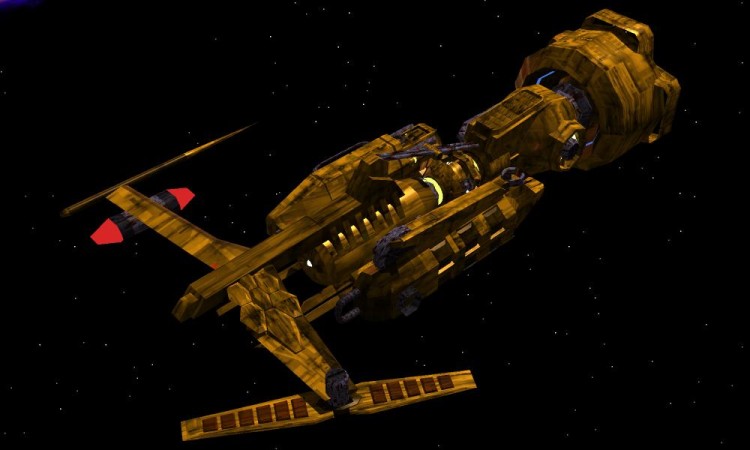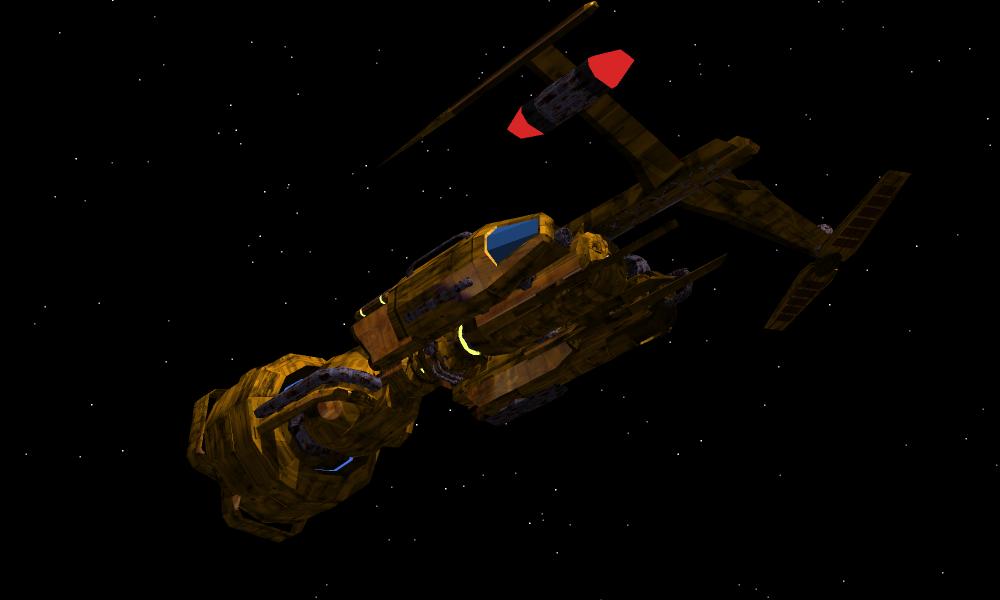Sidebar
Table of Contents
Eye-II Class Stealth Corvette
Small, fast stealth corvettes designed for long range sensory support, stellar cartography, stellar prospecting, and first contact missions, based on a ship found in orbit over planet 188-604. Expected to be added to the IIS production roster in late YE:39 with a trial production run of 92 units and expected to be surpassed by IIS's Eye-III Class Stealth Corvette in late YE:40. Also one of the flagship craft for the BYOS program.
About the Ship
Based on the design of the “Eye in the Sky” scout ship discovered at 188-604 in YE 39,
The design choice was obvious for a person who would find a 10×10 prison cell luxurious, though a bit cramped for most pilots. Bare minimum, fast, with powerful sensors and engines on minimum viable power and computer systems. Unfortunately, with bare minimum in all defensive systems, anyone who didn't like her presence could easily shoot her down. Thusly, Thorn decided to add in the best stealth systems she could find, and develop some of her own based on existing technology and parts found on derelicts and in scrapyards. These made it into the Eye II class alongside some of IIS's own proprietary systems.
The result was little more than a manned probe, classified as a long range scout corvette.
Key Features
The ship is capable of gathering massive amounts of data in a short period of time, and is “biphasic” or of a two phase design.
When the pilot arrives at a contracted research planet, the satellite settles in to a stable orbit (Usually geosynchronous) and jettisons both pods. The cargo pod follows the living pod closely as it defrosts the pilot and enters the atmosphere. When the contract is complete, both pods are loaded into a cargo ship to be jettisoned in orbit and collected by the satellite core. Raw data is processed on board and en route to home orbiting stations, where the ship docks as one piece for repairs and modifications as needed for the next mission.
This ship boasts some of the highest sensor power to size ratios in the Kikyou Sector. It also boasts maneuvering and raw acceleration capabilities well outside the capacity of many starfighters' performance threshold, if it holds together under the tortioning forces, and as long as the inertial dampers aren't damaged. Due to being powered by a fusion bottle reactor one might find on a midbulk transport, the ship has enormous power reserves, with fifty percent of base power capable of routing to sensors, or jumping at a mere 70% throttle. Theoretically, the jump capability is potent enough to ignore gravitational field effects of nearby stars.
Mission Specialization
- Stealth and Observation: Molecular scanning and technical scanning ability to produce high resolution images and detail down to blueprints
- Rapid Deployment/Movement: Max acceleration allowing zero to .45c in 45 seconds and low profile prevents targets lock and allows rapid escape.
Appearance
Pretty is not how one would describe this particular awkward bird. The hull is barely held together with welds and organic material, the engine mount beams are warped and cracked, patch welded and more weld than original beam. The reactor is exposed to space, an angry glow and offgasses marking its position far better than any anti-collision lighting, which the ship does not have. The view from the rear is obscured by the single massive cruiser's main engine fed directly off of the reactor's waste power. The hyperspace fold drive is visible and exposed to open space, sitting dangerously close to the cockpit and mounted just aft of the primary sensor core and a fourteen petabyte hard drive. Two winglets mounted either side of the hull balance the vertical profile with a set of sensor nacelles from the front, and curve outward to encompass the forward hull and obscure the pod mounts.
There is a layer of bronze colored organic growth over the entire frame, which is actually a silicon based photosynthetic skin that assists with structural integrity and uses specialized chromatophores to scatter radar, infrared, and X-ray imaging to obscure its image or prevent a target lock. Other stealth systems on board are less visible, but its comm firewall masks the comm behind background radiation in local area, preventing interception by prying eyes.
History and Background
Statistics and Performance
Rarity: Mass production run 1 of 92 units
General
- Class: Scout interceptor (Loose technicality)
- Type: Unarmed research vessel
- Designers: IIS technical teams
- Manufacturer: Iemochi Innovations & Sales
- Fielded by: Multiple buyers
- Nomenclature number (Model no.): IIS-Y1-2a
- Price: 40,000 KS (Base1) ) 48,000KS for base model with sensors and skin.
Passengers
Crew: 1
Maximum Capacity: 1
Options
All options replace the standard 2m3 cargo pod
- Mosquito Gun Pod (10,000 KS +Ammo cost) Cargo pod with attached 50mm railgun. Starfire, standard kinetic, probe, or orbital bombardment ammunitions optional. Also includes a sensor tie-in and computer based targeting compensator.
- Secondary Personnel pod (13,000 KS) Secondary reentry fitted cryogenic pod for personnel transport
- Oversize cargo pod (1,500 KS) Cargo pod of larger internal volume at cost of stealth, internal volume 3.5m3
- Enhanced sensor package (14,000 KS) Sensor system controller and booster package, increases detection ranges and scan detail
- FTL booster (12,000 KS) 30 liters of extra deuterium for reactor fuel and a micronized continuum distortion drive rated at 12 AU/Sec
Systems extras
- Aether-plasma inline thruster Delivers the same performance whilst negating engine power requirements (2,000 KS)
- Aether reactor More power is more better! 50% better power without requiring fuel! (Negates passive thermal stealth system) (5,000 KS)
Dimensions
- Length: 8 meters (26 feet)
- Width: 4 meters (13 feet)
- Height: 4 meters (13 feet)
- Decks: 0
Propulsion and Range
Eye in the Sky has bare minimum viable systems, and is thus, rather high maintenence, requiring constant refits and repairs. It has an open body hull with exposed support beams to save weight, and the habitable compartment is absolute bare minimum viable. Well below “Humane” limits for manned space flight.
- Hyperspace Fold Drive: 75 LY/hr
- Sublight Engines: Single engine, plasma rotor, top speed attained in 45 seconds 3.575 x 109 m/s ΔV
- Range: 40,000 light years single jump (533 hours, 20 min in hyperspace fold)
- Lifespan: Unknown (Constant refits and mods)
- Refit Cycle: 6 months (Or four jumps, as the ship tends to tear itself apart every 4-5 jumps)
Damage Capacity
See Damage Rating (Version 3) for an explanation of the damage system.
DR-3 ratings
- Hull: 6 based on size
- Armor: -4 (Open hull design, armor nonexistant.)
- Barrier: Tier 6 forward -2 (Standard space flight electromagnetic/inertial damping barrier, not rated for beam or kinetic weapons of any kind.) (Secondary barrier of Tier six front facing plate, deflector shield.)
Vehicle offers no ballistic or energy weapon protection, relying on sheer speed and small size to avoid fire, combined with stealth systems to prevent target lock.
Inside the Ship
Deck Layout
Cryo pod stuck to the top. No other livable space. Livable volume 5'X2.5'X2.5'
Compartment Layouts
Bridge
Single crew compartment.
The crew compartment is a single cryogenic stasis pod, modified to act as a short term living space for the occupant. Above the head is a cabinet to store an EVA suit or a change of clothes, a few ration bars, and some books for light reading while waiting for data to compile. There is an IV feed near the left side, pumping a sugar and nutrient blend, replenished via filtering water from the suit waste disposal system. Control is via a touchscreen interface on the forward glass panel of the cockpit and two joysticks deployable from the side walls of the pod.
Cargo Storage Areas
Cargo Pod
A simple reentry capable cargo pod with a follow mode on a beacon attached to the outside of the crew pod. Simple RCS giudance and soft landing thrusters and an internal volume of 2 cubic meters.
Ship Systems
Armored Hull and Hull Integrated Systems
Tier 6 size, -4 damage rating
Open hull design with systems exposed to space. Minimum viable to the point of not even having a proper hull.
Computers and Electronics
Single “dumb” AI primary computer control system, with data collection and storage of up to 14 petabytes.
Standard communications array uses a high power beacon style subspace radio and a noisemaker to mask the signal. It can also use the laser diode from the laser spectrographic sensor as a low quality laser communications signal, and can use the noncollinear sensor as a radio transmitter.
Laser: 50,000 km with minor distortion Short/longwave radio: 3AU undistorted, with 24 minute delay. Hyperspace radio beacon: 120 LY with 90 second delay
Emergency Systems
One distress beacon, automated and powered by an RTG rated at 200 years cryogenic emergency life support able to keep one Minkan or Nepleslian under cryogenic suspension for 110 standard years.
Life Support Systems
Nutrient feed line via permanent set IV for pilots, chemical/biological rebreather system with photosynthetic oxygen production.
Propulsion
Single main plasma rotor engine and fuel system.
Single hyperspace fold drive with integrated inertial damper
Optional inline Aetheric Plasma conversion engine. Same thrust. (Yamatai and Nepleslia clients only.) (Costs extra)
Barrier Systems
The Eye II-Class has a Standard geomagnetic shield rated for most radiation found in deep space and a single forward facing plate barrier system for repelling oncoming debris. No other shielding systems.
Weapons Systems
Unarmed
Power Systems
Single Tokomac fusion bottle, unshielded, thermo/radiovoltaic collector. Output rating nearly four terawatts per second. Fuel preheater and mass based thermal seperator. Fuel is elemental deuterium with tritium spike.
Optional Aetheric reactor (Yamatai clients only) (Costs extra)
Stealth Systems
Below is marked the stealth systems used by the Oracle, alongside intended effects and theoretical applications.
- Distributed fuel preheater Surface temperature of 105 degrees Kelvin, slightly below local space, rendering ship passively nondetectable on thermal imaging.
- Chromatophore overskin By using advanced biotechnology inspired skin, chromatophores render optical identification nearly impossible due to shifting patterns of shades of black and RADAR scattering properties. 2)
- Faraday cage over power systems Electron motion and EMF measurements near impossible due to EMF blocking properties of Faraday cages
- Tactics Uses nearby large bodies to hide mass, often by hiding near large asteroids or nearby ships
- Kaleidoscopic quantum projector By projecting the quantum signature of gadolinium ore via from the noncollinear sensor array, it masks its own quantum mirror signature behind what appears to be a mass of ore.
Sensor systems
Below is marked the basic sensor clusters of the Eye II class without regard to their location on the hull, which can be found in Appearance.
- 220,000 element noncolinear phased array (variable wavelength transceiver) A combined magnetic resonance, electron motion, and radar array with active scan functionality. Also helpful in projecting a supposed quantum event or state.
- Geomagnetic sensor cluster A series of hall effect and electric field sensors designed to detect and evaluate magnetic fields, usually planetary, but useful in detecting and evaluating another ship's barrier system.
- six Quantum Mirror sensor cluster Used to determine quantum events such as hyperspace fold or continuum distortion jumps.
- Penetrating Radar Can penetrate a ferrium hull up to two hundred meters and determine decks and equipment placement, originally designed for locating geology under foliage from orbit and mapping near surface cave systems.
- Laser spectrograph Simple laser spectrograph used to determine surface composition of an object.
- Scalar gravitational field sensor Simple mass sensor, useful in determining where something is and how much mass is there.
OOC Notes
Article created by Madi Harper with final edits by ethereal to integrate into IIS roster as a class of ship rather than original custom.
Approved by Ametheliana on 23 November 2017
Page Tools
Terms of Service - Privacy Policy


